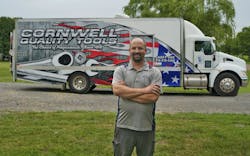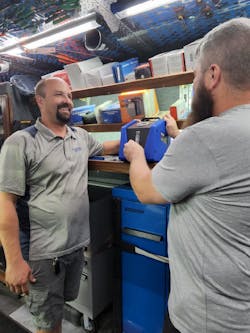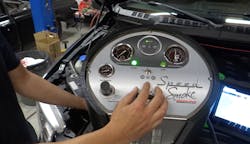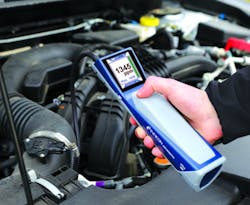Content brought to you by Professional Distributor. To subscribe, click here.
Finding a leak on a vehicle can often leave technicians feeling like they are looking for a needle in a haystack. Leaks are inevitable and can occur anywhere on a vehicle. Having the right tools and knowledge on different leak detection methods will help technicians get the repair done faster, saving them hours of frustration.
Before becoming a mobile tool dealer, Casey Cox worked as a technician and can relate to the pain points of finding leaks.
“From refrigerant leaks to engine oil leaks to emissions leaks, technicians see most of them on a day-to-day basis,” Cox said.
He notes that leak detection tools save a lot of time, keep the cost of the repair down, and take the guesswork out of locating the leak.
“Otherwise, you’re just kind of guessing,” he says.
Now as a Cornwell Quality Tools distributor for the past four and a half years with a route in the south part of Wichita, Kan., Cox said he has a better understanding of leak detection tools now than when he was a tech.
As a tool dealer, he started messing around with the tools more. It not only makes selling the tools easier but more importantly to him is that it gives him the ability to steer his customers in the right direction to get the right tool for the job.
Smoke machines
Smoke machines are used to visibly indicate vacuum leaks and smoke leaks in a vehicle. There are two different styles: Low pressure and high pressure.
Low pressure, or EVAP, smoke machines are used in sensitive areas that only see pressures under 1 psi such as EVAP, intake, crankcase, and exhaust systems. These machines are regulated at .5 psi and are designed for naturally aspirated engines. They can also be used to locate vacuum leaks as well as wind and water leaks inside vehicles like around windows, doors, and the dash.
High pressure, or turbo, smoke machines are used in areas that see pressures upwards of 30 psi. They are designed for testing turbo, diesel, and supercharged engines. They allow technicians to simulate boost conditions of a running engine for testing with the engine safely off.
“Technicians cannot see air,” says Mark Hawkins, manager of technical solutions, Redline Detection. “On occasion he can hear an air leak, but he can’t visualize it.”
With all the hoses and plastic protective coverings under the hood, it can be difficult to hunt down a leak in a reasonable amount of time unless you have some kind of visual aid such as a smoke machine, Hawkins says.
A smoke machine works by heating the smoke producing fluid (such as mineral oil) to create a steam, or visible vapor.
Once the correct amount of fluid is added to the smoke machine, the machine is connected to the vehicle to fill the entire system being tested. The technician can then look for any vapors escaping.
One feature that Cox says is popular with his customers is a smoke machine with a built-in air compressor.
“A lot of my guys do side jobs at home and many of them have moved to cordless tools, so they don’t have an air compressor,” he says. “Having a built-in compressor enables them to take it home, or out on a service call. They can also put it on top of the vehicle with its hooked up and raise up the vehicle and not worry about an air hose dragging around.”
More recently, manufacturers began offering both low and high pressure testing in one machine.
Redline Detection’s SpeedSmoke is one example. It was based off OEM mandated technology used by General Motors, Mazda, Nissan, Jaguar Land Rover, and more. The company decided to take the same technology and develop a version for independent repair shops. In addition to providing dual pressure testing, it also features an onboard air compressor for portability.
In electric and hybrid vehicles, it’s important to note that smoke machines cannot be used. The visible vapor produced is a contaminate in these systems. That’s why Redline Detection introduced the EV Battery + Coolant Leak Detector.
It’s designed to connect to the battery enclosure on or off the vehicle and ensures that battery enclosures and coolant systems are sealed under precise pressures, specific to the battery and vehicle type.
It also provides audible and visual progress cues and pass/fail indication when testing is complete.
Selling tips
Smoke machines are one of those items that if customers don’t see it on the truck, they won’t buy it, Cox says.
“Smoke machines are a bigger purchase,” he says. “It’s easier for them to commit to it when it’s on the truck.”
Generally, a technician will come to him looking for one. If they’re unsure about which style of smoke machine to get, Cox will first inquire about the leaks they’re dealing with – whether more EVAP leaks, intake leaks, engine leaks, or something bigger – and then figure out which unit is best for them.
When purchasing a smoke machine, technicians should consider the quality of the tool, its warranty, availability of replacements parts, and whether it offers service support in case they have questions, Hawkins says.
Additionally, smoke machines often don’t come with all the adapters needed which can be frustrating for technicians in the middle of a repair. For a mobile tool dealer, this can be a great opportunity for an easy add sale.
Fluorescent dyes
Fluorescent dyes, or UV dyes, detect leaks in fluid-based systems such as A/C systems with compressor oil, coolant systems, radiator systems with coolant, and in engine-based oil fluids (engine oil, transmission oil, fuel, and power steering fluid).
Like smoke machines, adding fluorescent dyes to a system enables technicians to visually see a leak.
“It’s very easily distinguishable,” says Jack Kelly, vertical marketing strategist, automotive, Tracer Products. “And you don’t need a lot of training.”
There are three major fluorescent dyes: Coolant dyes, oil-based dyes, and A/C dyes.
When using a coolant dye, which are now available in various colors, it’s important to make sure that it doesn’t affect the color of the original coolant, Kelly notes.
“When technicians look under the hood and at the coolant reservoir, one of the first things they do is look at the color or clarity of the coolant,” he says.
For oil-based dyes, since a leak could spread across different systems technicians can use multi-colored dyes to pinpoint the exact source of the leak.
As for A/C dyes, there are three types: R-1234yf/PAG, R-134a/PAG, and universal/ESTER.
If a vehicle is within warranty and is being serviced by a dealership, Kelly says they will typically go with the R-1234yf or R-134a for the specific system. However, there are some shops will only want the universal A/C dye on hand and not deal with the others.
Once a dye is added to a system, it stays within the system until the host fluid is replaced.
When adding fluorescent dyes to a system, it’s important to make sure it’s up to SAE standards and it’s fully compatible with the system, Kelly advises.
“A well-trained technician will first want to make sure it adheres to industry standards,” he says. “[And] that it’s not going to have any ill effect on the components that’s being serviced.”
Selling tips
Since most vehicles now come with dyes already in various systems, Cox tends to sell more UV lights and glasses than he does kits. He likes to always keep a few different options on the truck even though he sells more in the summer months.
“It’s critical for technicians to use a light that has an even and broadly distributed intensity profile,” Kelly notes. “UV leak detection is very popular but if you’re not using the right wavelength or it doesn’t have a great area of focus, then the method itself is going to be less than optimal.”
The Opti-Pro UV Max Series from Tracer Products feature Spot Power, a metric to gauge lamp performance. Spot Power is the area within the beam profile that is optimal for activating fluorescent dye. The flashlights also have an adjustable focus lens, a strobe light mode, and a 30 to 35’ range.
Kelly recommends mobile tool dealers to dab a little LeakFinder oil dye on a piece of paper and place it at the other end of the truck. Then use the Opti-Pro UV Max to show the customer the fluorescents.
It’s also important to make sure your customer has the right adapter to service R-1234yf A/C systems. It’s usually included in a kit but can be sold separately.
Electronic leak detectors
There are two categories for electronic detectors: Refrigerant and ultrasonic leak detectors.
Electronic refrigerant leak detectors are very specific for finding A/C leaks. Unlike the other methods mentioned so far in the article, technicians will hear a beep or noise when a leak has been detected.
“An A/C system leak is very different than say an EVAP leak that a smoke machine would use,” says Matt Farel, worldwide sales manager, automotive aftermarket, INFICON. “[An A/C] leak is a leak under pressure that’s going to leak about 1 or 2 oz. a month. It’s a very minuscule leak but will create a huge problem.”
With no prep work involved, an electronic refrigerant leak detector is easy to use. Simply turn the tool on, wait for it to warm up, and then run the tool along the components, following the noise.
It works by pulling an air sample into and across a sensor. If the sensor reacts with refrigerant, it’ll create a sound.
The tool has a probe that can fit into a tight engine cavity. Because it creates an air flow, it can pull an air sample from an area allowing technicians to “see” the backside of a component compared to visual methods like dyes, Farel notes.
There are two primary sensor types in electronic refrigerant leak detectors: Chemical reaction/CMOS sensors and infrared sensors.
Infrared sensors tend to last longer, are less prone to cross-contamination, and are more sensitive, Farel says.
The AST300PPM from INFICON is an example of one that utilizes an infrared sensor. It’s able to detect both R-1234yf and R-134a refrigerants and features a large, full-color LCD display. It also offers a leak seeking mode (beeps louder/lights flash as you get closer to the leak) and can tell you the size of the leak in parts per million (PPM).
When it comes to finding really hard-to-find refrigerant leak, Cox says electronic refrigerant leak detectors work very well.
The only downside is the chance of getting the tip of the probe contaminated such as if it brushes up against a hose that that oil on it, he notes.
Cox makes sure to always stock at least one on the truck. It’s not a high moving item, but it’s one of those that when a technician needs it, he needs it now, he says.
Ultrasonic leak detectors can be used to find air brake leaks, intake leaks, exhaust leaks, vacuum leaks, air leaks (including tire leaks), and electronic leaks.
The tool emits an ultrasonic sound and then converts it into a natural sound that the technician can then hear, Tracer Products’ Kelly says.
“Depending on the application, there’s a variety of different sounds,” he says. “For electronics, you might hear static and for a compressed air leak you would hear a hissing sound.”
It could also be used for A/C leaks if there was refrigerant leaking from the system and there wasn’t UV dye.
Selling tips
Most electronic refrigerant leak detectors over the years have been converted to work with both R-1234yf and R-134a. However, Cox says that is something customers need to be aware of – that the tool can do both, especially as more and more shops are adapting to R-1234yf.
Farel agrees. Making sure the tool is SAE 2791 (R-134a) and SAE J2913 (R-1234yf) certified is important. That means it has been tested for automotive use.
A feature hitting the market to be aware of is the integration of UV lights. Since most new vehicles come with dye pre-loaded in the A/C system, some electronic refrigerant leak detectors now have built-in UV lights, Farel adds.
Conclusion
As Cox previously stated, leaks are a common occurrence technicians face every day. If not done properly, the shop not only risks comebacks but also loss in revenue and an unhappy customer.
Since there’s not one, universal leak detection tool to find every type of leak, oftentimes more than one method may be needed for the repair, depending on the application.
Product knowledge is one thing, but it’s also about helping your customers.
“I always like knowing what my customers are looking for,” Cox says. “I don’t want to push them in a direction that they don’t need to go in.”
About the Author
Kayla Nadler
Associate Editor | Vehicle Repair Group
Kayla (Oschmann) Nadler was previously an associate editor for the Vehicle Repair Group.
With an education in journalism and public relations, Nadler contributed to Professional Tool & Equipment News (PTEN) and Professional Distributor magazines, as well as VehicleServicePros.com.




